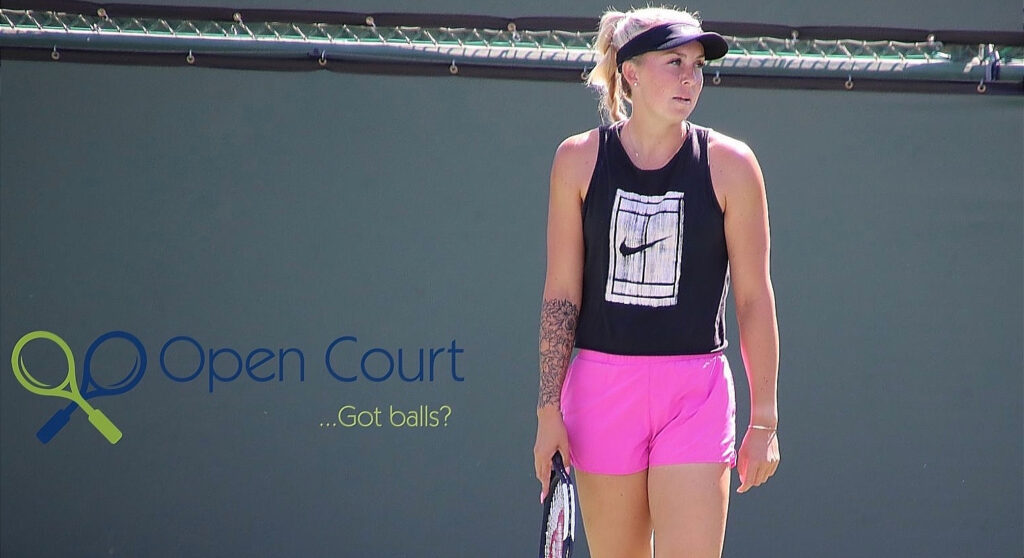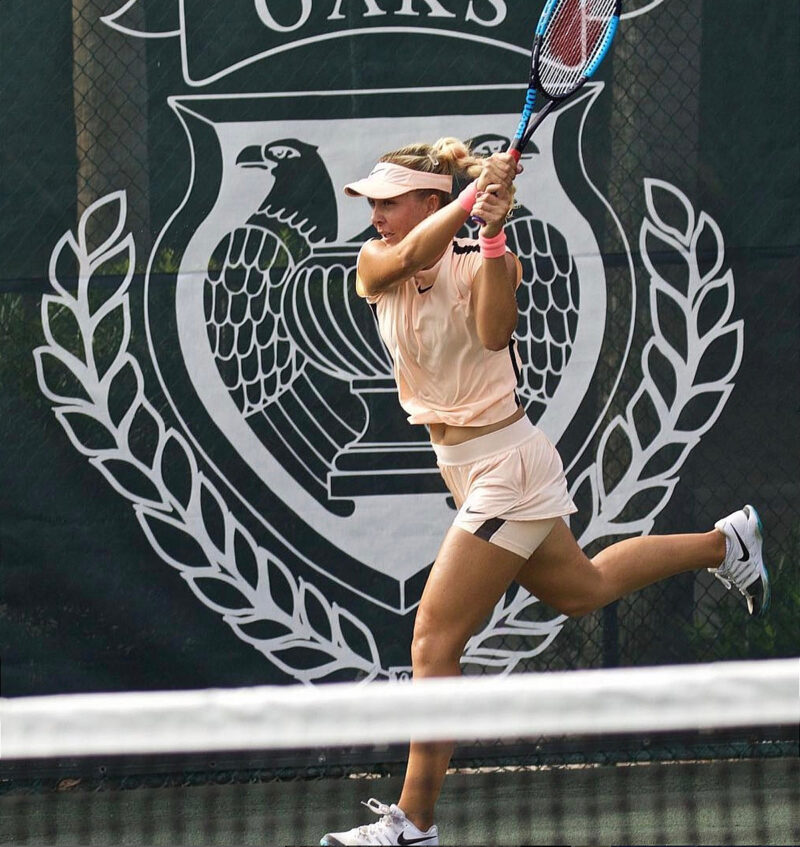
Kratzer practicing at Indian Wells in 2020. The next day, the tournament was cancelled and COVID took over our lives.
–
Ashley Kratzer is a name that won’t be familiar to most of you, because her career had hardly begun before it was stopped in its tracks.
But the once rising American finally returned to the competitive match court last week after 4 1/2 years away.
The interim had to be an exercise in extreme frustration – a very expensive trip through the anti-doping appeals sytem that was ultimately unsuccessful.
And all because of … blisters, mixed in with a bit of desperation and a lot of naiveté.
The 6-1 lefthander was on the come-up when she made the top 200 at the age of 19, despite having played almost no junior tennis.
She played – and won – the 2017 US girls’ nationals without even having a junior ranking, on the basis of her WTA ranking at the time.
That earned her a wild card into the US Open main draw that year, where she lost to Tatjana Maria.
–
–
She’s actually in this Wilson promo video with Serena Williams, all the way back in 2013.
But during those first few crazy weeks at the start of the pandemic in mid-March 2020, Kratzer was notified that she’d come up positive on a doping test done that January, at a Challenger in her hometown of Newport Beach where she had been given a wild card.
Just a few weeks before she got that news, Kratzer had been set to make her big debut at the Indian Wells tournament, after winning a pre-qualifying tournament and getting a wild card into the qualies. (The featured photo in this post is from that tournament). But the day before it was to start, Indian Wells became the first casualty of COVID – as we all remember all too well.
She probably thought that was the end of the world.

It was about to get much worse. A couple of weeks later, the notice of the positive test.
Seven months later in Oct. 2020, Kratzer’s case was finally heard by the ITF’s independant tribunal.
The decision can be found here.
The details outlined below all are taken from that decision document.
The tribunal heard about a “longstanding, severe blistering problem on the heels, toes and sides of her feet – bad enough that she often bled through her shoes.
A few months prior, she had travelled to Anning, China for a WTA event, without her coach.

So she arranged for a Chinese coach to work with her during her prep, through the front desk at the resort hotel where she was prepping. And when those blisters appeared, the coach – whom she knew only as “Zhang” – provided her with a pump bottle of creme he said a number of Chinese players used. The bottle, which may once have had a label, was sticky and unlabelled, she told the tribunal.
Then 20, Kratzer said she just took the coach’s word that it was an “anti-bacterial cream”, like Neosporin that she used religiously even though it offered only the slightest bit of relief. She returned to the U.S. with the bottle; after so many years of fruitlessly searching for a solution to the blisters, she found it helpful both with healing the blisters and alleviating the pain.
She said she used it for about a week leading up to that Newport tournament, and put some directly on the blisters the day of the match that preceded the doping test.
The American hadn’t listed the creme on her doping control form because, she thought, it wasn’t a prescription medication. So there was no need.
Kratzer provided a number of the cremes and supplements she had been using to the ITF for testing, following the positive test. But it was only when she sent a sample of this creme that the source of the positive test was revealed, it contained “a significant amount of GHRP-6, the human growth hormone-like substance that triggered the positive test.
Coach “Zhang” disappears into thin air
Kratzer, who had never followed up or attempted to get more of the creme despite its effectiveness, then tried to track down the coach. The resort where she was training didn’t know anyone named “Zhang”. The Chinese Tennis Federation was no help; of course, the language barrier was significant.
Kratzer was not part of the registered testing pool, and she said she had only ever been drug-tested twice. All she really knew about the process came from getting documentation and passing the annual online multipe-choice test.
The substance in question is approved neither in the U.S. nor in China, the WADA physician testified. So it was obtained on the black market. Further, it wasn’t just a contaminated product; the banned substance was a significant, base ingredient in the creme.
The Montreal-based WADA physician, Dr. Christiane Ayotte, was of the opinion that the usage of the creme described by Kratzer didn’t explain the amount found in her system. But they were satisfied that the creme was how the substance got there.
Beware strangers bearing “gifts”
The ITF contended they couldn’t find justification to reduce the suspension to less than the prescribed four years, because those reductions go to lack of intention.
Kratzer and her lawyer argumed that because she didn’t intentionally violate the anti-doping rules, she should get two years instead of four – less than that, 16 months, because she was not “significantly at fault”.
— Ashley Kratzer (@AshleyKratzer) September 9, 2013
Ultimately, the tribunal dismissed those arguments, which they said were irrelevant given she acceptance a substance from someone she had just met, whose full name did didn’t even know, and whose medical training or experience – if any – was unknown to her. And the creme was not even labelled.
As a result, they ruled she really should have seen the red flags. Further, they considered her efforts to find coach “Zhang” limited in that, acknowledging the language barrier, she didn’t hire an interpreter or translater to try to get to the bottom of it.
The full four-year suspension was backdated to the date of her provisional suspension.
Appeal to the CAS
That wasn’t the end of the story for Kratzer, who appealed the decision to the Court of Arbitration for Sport.
She was well supported, too; her lawyer was Howard Jacobs – well known for many of the tennis cases he’s argued before the CAS. That includes the recent successful appeal by former world No. 1 Simona Halep.
There was only one arbitrator, a Swiss law professor named Ulrich Haas.

Further details to emerge from that case were that Kratzer hadn’t used the creme on the days she played in China because it prevented her tape from sticking to her feet. So she first applied it on her way home from China and once home, realized it was effective and that within four days, the blisters began to heal.
Notably, even after returning home, Kratzer made no effort to get more information about the creme – which, logically, she might have because after years of being unable to find a solution for the blisters, along came this very effective medication. That alone should have sent up red flags for a drug-tested athlete.
Suspension … upheld
Kratzer’s appeal to the CAS was filed on Dec. 11, 2020, then she requested and was granted a deadline. By Jan. 19, she advised the CAS that a hearing wasn’t necessary. Five days later, she asked for the hearing to be held again.
It was was finally set for May 4. And the response finally came on Jan. 15, 2021.
The key for Kratzer was to show on balance of probability that she “didn’t know her conduct involved a significant risk or that she did not manifestly disregard such risk”.
For Kratzer, the defence against her having acted intentionally or recklessly came because she felt intense pressure, on the other side of the world, by herself – knowing that her parents were paying her significant expenses and knowing if she couldn’t solve the blister issue, she’d have to withdraw from the tournament.
But that defence, even if reasonable, fell by the wayside once she arrived home and continued to use the creme – knowing it was (for some reason) more effective than anything else she had tried. And she never pursued more information.
Kratzer did tell her parents about it, she testified. But they also didn’t apparently see the red flags.
In the end, the arbitrator upheld the ITF’s decision for a four-year suspension. The entire decision is here.
That suspension expired at midnight on March 27, 2024.
Kratzer had just turned 21 when it all went down. She’s now 25.
She’s BACK!
Fast forward a few months from her reinstatement, and Kratzer returned to competitive action last week.
There are plenty of opinions, and plenty of decisions one way or the other revolving around whether a player who has had a doping suspension should be awarded wild cards. We notably remember some of the reaction when Halep got one into the Miami Open.
But this apparently was not a problem for Kratzer last week as far as the USTA Pro Circuit was concerned.
She was granted a wild card into the main draw of the Women’s Hospital Classic in Evansville, Indiana – a $60,000 ITF tournament.
(The trolls and the wagerers found her Instagram account, which hadn’t been updated since 2018, almost immediately. They are relentless).

In the first round, she defeated Annika Penickova in a third-set tiebreak. Penickova, just 14, qualified and won a round at junior Wimbledon a few weeks ago.
Kratzer was then beaten by No. 243-ranked Himeno Sakatsume of Japan, 22, 6-3, 6-4 in the second round.
Kratzer officially entered both the $40K ITF in Dallas this week, another $60K in Lexington, Kentucky next week and a $100K tournament in Landisville, PA the week after. She didn’t get a wild card this week.
But without any kind of ranking, that’s about her only option.
She’s certainly not too old to come back; far from it. But she likely will have to be prepared to go to one of the Futures factories in Tunisia, or Egypt where you can get into qualifying without a ranking and grind her way back.

More Stories
ATP Rankings Report – As of Oct. 20, 2025
WTA Rankings Report – As of Oct. 20, 2025
What a week for the Canuckians